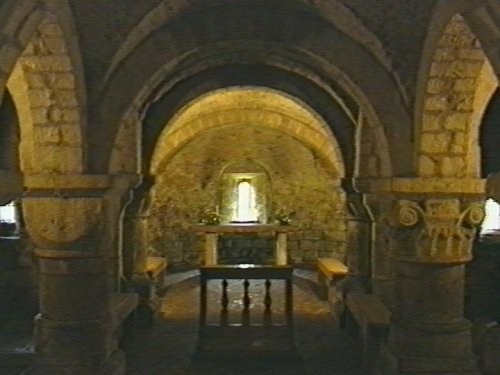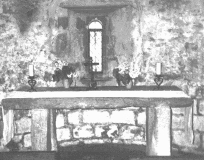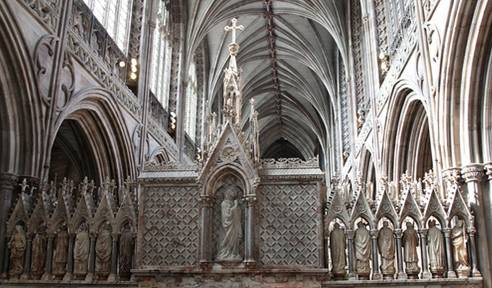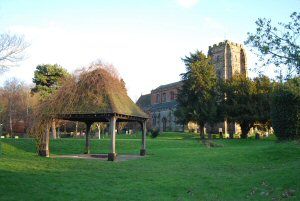(† 672)
| Orthodox Outlet for Dogmatic Enquiries | Biographies |
|---|
|
Saint Chad (Caedda),
bishop of Mercia (Lichfield)
(† 672) |
|
A first approach to the indigenous Orthodox Saints and Martyrs of the Ancient Church who lived and who propagated the Faith in the British Isles and Ireland during the first millennium of Christianity and prior to the Great Schism is being attempted in our website in our desire to inform our readers, who may not be aware of the history, the labours or the martyrdom of this host of Orthodox Saints of the original One, Holy, Catholic and Apostolic Church of our Lord.
"The Church in The British Isles will only begin to grow when she begins to venerate her own Saints" (Saint Arsenios of Paros †1877)
|
Everything we know of this great hierarch comes from the writings of St. Bede in his "Ecclesiastical History", written in 731. St. Chad, the youngest of four brothers, was born into a humble Northumbrian family near the beginning of the seventh century. His brothers, St. Cedd, St. Cynebil and righteous Caelin all became monks. A family of saints, these four men studied under the great sainted-hierarch and monk, Aidan of Lindisfarne. Saint Aidan was a great source of spiritual insight to these four men, all four became priests of the holy Church. They were sent to Ireland under the great geron (elder) and saint, Egbert, at the monastery of Rathmelsige (Melfont), for advanced study and training in the monastic life. Chad worked tirelessly with his brother Cedd (who had been made bishop of London), they established the monastery of Laestingaeu, now Lastingham in Yorkshire. Upon the death of his brother Cedd in 664, Chad succeeded him as abbot. The Humble BishopSt. Wilfrid was chosen to become bishop of Lindisfarne after the death of bishop Tudi. He travelled to Gaul for consecration and remained so long absent that King Oswiu (ruler of Northumbria) demanded a bishop. Having learned of the missionary exploits and great humility of Chad, called for his election as Bishop of York, to which place the See of Lindisfarne had been transferred. St. Chad was consecrated (uncanonically) by Bishop Wini of Worcester and two schismatic British bishops to the See of York. Saint Chad was hesitant to be bishop, he wanted no part of it, but ultimately he was obedient. As bishop of York, he was much beloved by his flock, travelling great distances on foot to care for his "little sheep." When St. Wilfrid returned to York and found out his See was given away, he made no objection and retired to a monastery in peace. Saint Chad, a Celtic Bishop, played a huge role in unifying the Church in 664 by accepting and recommending to his fellow bishops the adoption of the Orthodox Nicene calendar.In the year 668, Saint Theodore of Tarsus assumed the central Cathedra and became Archbishop of Canterbury and immediately sought about reforming the churches in England and Ireland. Up until this time, the Church in the Isles was not following proper canonical order set down by the Ecumenical Councils. St. Theodore of Tarsus was sent by the Pope of Rome to restore order in the British and Irish churches. Saint Theodore was a wise bishop and a deeply spiritual monastic. While travelling to York he was shocked to find that St. Wilfrid was not the canonical bishop of York. The consecration of St. Chad was uncanonical due to three points made by St. Theodore:
1. The
British bishops refused to acknowledge the canonical
(Julian) Church calendar established by the Ecumenical
Council of Nicea (of which Rome and the four Eastern
Patriarchates adhered to) St. Theodore decided that in good church order, St. Chad must give up the See of York to it's rightfully elected bishop, St. Wilfrid. St. Chad in astounding humility responded, "If you decide that I have not rightly received the episcopal character, I willingly lay down the office; for I have never thought myself worthy of it, but under obedience, I, though unworthy, consented to undertake it." Seeing in him a true bishop, a man of such humble and angelic character, St. Theodore pleaded with Chad to continue in his archpastoral ministry. St. Theodore provided what was lacking from St. Chad's consecration ("ipse ordinationem ejus denuo catholica ratione consummavit" - Bede, Hist. Eccl. IV, 2) and completed the rite according to the Orthodox Roman Rubricon. St. Wilfrid remained as bishop of York and St. Chad returned to his monastery in Lastingham (images below). 

 Lastingham - the Monastery and the underground Crypt
with ancient Altar
Lastingham - the Monastery and the underground Crypt
with ancient Altar
The MissionaryIn 669, King Wulfere demanded a bishop for his people in Mercia. St. Chad was called on by St. Theodore of Tarsus to be archpastor of the Mercian people. Mercia was a land of deeply rooted pagan beliefs, and a large area at that. St. Chad considered this to be his true work, bringing the Mercian people to Christ. He soon discovered that a great persecution occurred on the plains of Lichfield, deep within the Mercian lands. The Roman emperor Diocletian had exterminated 1000 martyrs on the plains of Lichfield in the year 303A.D, they are known as the Martyrs of Lichfield. St. Chad considering this to be a holy place moved the See of Mercia from Repton to the exact spot of the massacre in Lichfield, where his new diocesan Cathedral and Monastery were to built. St. Chad is considered the first bishop of Lichfield. As Bishop of Lichfield, Chad carried out his missionary and pastoral work with zeal. The kingdom of Mercia was huge, and Chad spent much of his time travelling by foot. In accordance with the Celtic tradition, in which he had been brought up, he at first insisted on making all journeys on foot, following the example of the apostles. However, St. Theodore insisted that Chad used a horse for long journeys. St. Chad, unwilling to do anything that he felt would put him above the common man, refused, but Theodore, St. Bede tells us, "lifted Chad bodily onto the horse himself." The WonderworkerHis exploits were known throughout all Mercia, St. Chad was known to have retired, from time to time, to the bottom of a smalll well where he could contemplate and "pray without ceasing." The people would say that they knew when St. Chad was in his well, "a light like that of the sun, would shine from the bottom of the well." St. Chad was seen in the uncreated light by countless many. His humble prayers could easily cure illnesses and demonic possession. A gifted man of prayer he was also a source of forgiveness even to those who would seek his destruction. King Wulfere was a pagan, but also a good statesman. He used Christianity to control his subjects, he secretly despised the Faith. One day, the sons of Wulfere, Princes Wulfade and Ruffin were out hunting a dear near the saint's cell, when they approached the saint and asked about "the One called Jesus". So struck by the holy elder's words they both asked to be immediately baptised into Christ's holy Church. Wulfere, so enraged by the actions of his sons, killed them with his own hands. Afterwards, filled with such remorse the King suffered in both body and spirit by the loss of his children. He was counselled by his queen to ask the holy elder to forgive him and to hear his confession. As he approached the holy hierarch's cell he was witness to a great sight, the uncreated light of Tabor that shown upon the saint's visage. The king fell down in prostrate and begged his forgiveness and to truly bring him into the Orthodox Christian faith. As a penance for the murder of his children, the saint told him to build churches and monasteries in the name of Jesus Christ. He did so, and up until the end of the saint's earthly life, King Wulfere remained a humble servant of the holy elder. The Seer of AngelsOwini, a novice monk under St. Chad's care, was working alone in the fields near Chad's residence. When he heard the sound of singing apparently descending from the sky to the rectory where the saint was praying. The angelic chanting could be heard for half an hour before returning heavenwards. Chad then summoned his monks and, after urging them to live good Christian lives and to continue in keeping the rules of monastic discipline, announced that he would soon die. When the other fathers had gone away, Owini returned to Chad and begged to know what the singing had been that he had heard. St. Chad replied that he had been visited by angelic hosts summoning him to heaven and that the angels would return in seven days to take him to heaven. He then commanded the young monk to tell no one of this until after his death. St. Chad was quickly taken ill (probably by the plague) and on the seventh day (March 2, 672), "his holy soul was released from the prison-house of the body and, one may rightly believe, was taken by the angels to the joys of heaven". St. Chad was bishop of Lichfield and Mercia for just three years; his emulation of Christ ended as it began. Bede goes on to tell us that he was called "saint" immediately after his death. Miracles and cures of all ailments occurred at the place of his death, his reliquary, his well and anywhere his holy relics travelled. (His holy relics are preserved in the Roman Catholic Cathedral that bears his name in Birmingham, England.)
================================================
Historical information on Saint Chad and Lichfield
St Chad was the first bishop of Mercia and Lindsey at Lichfield. He was the brother of Cedd, whom he succeeded as Abbot of Lastingham, North Yorkshire, and a disciple of Aidan who sent him to Ireland as part of his education. Chad was chosen by Oswi, king of Northumbria, as bishop of the Northumbrian see, while Wilfrid, who had been chosen for Deira by the sub-king Alcfrith, was absent in Gaul seeking consecration shortly after the Synod of Whitby (663/4). Faced with a dearth of bishops in England, Chad was unwise enough to be consecrated by the simoniacal Wine of Dorchester, assisted by two dubious British bishops. Wilfrid on his return to England in 666, found that Alcfrith was dead or exiled and retired to Ripon, leaving Chad in occupation. But in 669 Theodore, Archbishop of Canterbury, restored Wilfrid to York and deposed Chad (who retired to Lastingham), but soon reconsecrated him to be bishop of the Mercians. This unusual step was due both to the new opening for Christianity in Mercia and to the excellent character of Chad himself, whom both Eddius and Bede recognised as being unusually humble, devout, zealous and apostolic. Chad's episcopate of three years laid the foundations of the see of Lichfield according to the decrees of Theodore's council at Hertford, which established diocesan organisation. Wulfhere, king of Mercia, gave him fifty hides of land for a monastery at Barow (Lincolnshire); he also established a monastery close to Lichfield Cathedral. Chad died on March 2nd 672 and was buried in the Church of St Mary. At once, according to Bede, he was venerated as a saint and his relics were translated to the Cathedral Church of St Peter. Cures were claimed in both churches. Bede described his first shrine as 'a wooden coffin in the shape of a little house with an aperture in the side through which the devout can...take out some of the dust, which they put into water and give to sick cattle or men to drink, upon which they are presently eased of their infirmity and restored to health'. His relics were translated in 1148 and moved to the Lady Chapel in 1296. An even more splendid shrine was built by Robert Stretton, bishop of Lichfield (1360-85) of marble substructure with feretory adorned with gold and precious stones. Rowland Lee, bishop of Lichfield (1534-43), pleaded with Henry VIII to spare the shrine: this was done, but only for a time. At some unknown date the head and some other bones had been separated from the main shrine. Some of these, it was claimed, were preserved by recusants, and four large bones, believed to be Chad's are in the Roman Catholic cathedral of Birmingham.  The
original shrine of the Saint
The
original shrine of the Saint
A fine Mercian illuminated Gospel Book of the 8th century called the Gospels of St Chad was probably associated with his shrine, as the Lindisfarne Gospels were associated with the shrine of St Cuthbert; it is now in Lichfield Cathedral Library. The 11th century shrine list mentions the relics of Cedd and Hedda resting at Lichfield with Chad. Thirty-three ancient churches and several wells (image below) were dedicated to St Chad, mainly in the Midlands. There are also several modern dedications.  Saint Chad's well
Saint Chad's well
|
Article published in English on: 20-3-2011.
Last update: 20-3-2011.